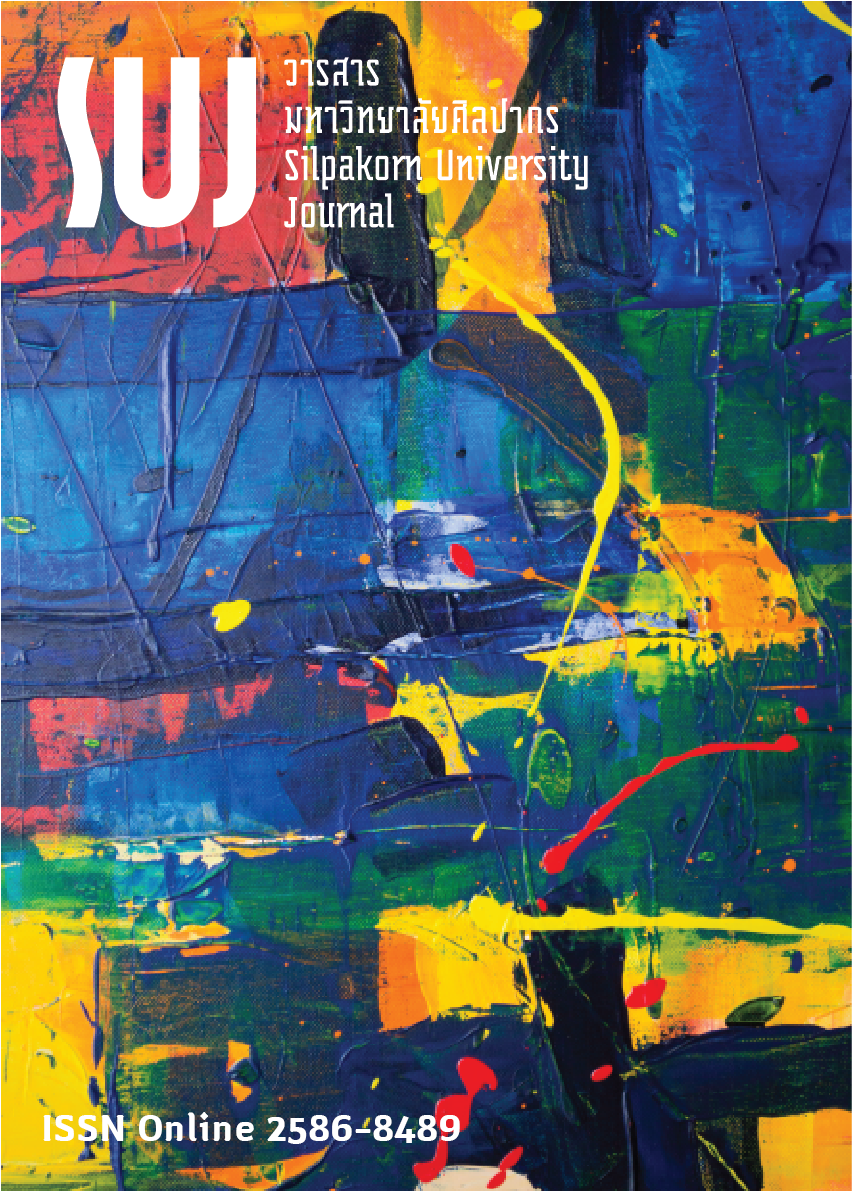ฉากสวรรค์ในภาพภูมิทั้ง 6 ระหว่างยุคกลาง-ต้นยุคก่อนสมัยใหม่ในประเทศญี่ปุ่น (Images of heaven in Japanese paintings of the Six Realms between Medieval and the Beginning of Early-Modern periods)
Main Article Content
Abstract
บทความนี้มีวัตถุประสงค์เพื่อวิเคราะห์แนวโน้มความเปลี่ยนแปลงขององค์ประกอบภาพสวรรค์ในภาพภูมิทั้ง 6 ของญี่ปุ่นระหว่างยุคกลาง-ต้นยุคก่อนสมัยใหม่ ผู้เขียนพบว่าในช่วงศตวรรษที่ 16 มีการลดองค์ประกอบที่แสดงความทุกข์ของเทพสวรรค์ และตัดทอนพื้นที่ของสวรรค์เมื่อเปรียบกับภูมิอื่น นอกจากนี้ยังได้สืบค้นว่าในงานเขียนทางพระพุทธศาสนาช่วงดังกล่าวอธิบาย “สวรรค์” ไว้อย่างไร เพื่อลองนำมาวิเคราะห์ร่วมกับลักษณะภาพสวรรค์ที่เปลี่ยนแปลงไป
The aim of this paper is to analyze the changes of motifs and composition of heaven in Japanese paintings of the Six Realms between the medieval and the beginning of early modern periods. After the analyzing process, it was found that motifs of suffering and space of heaven had been reduced significantly in the 16th century. Moreover, in order to investigate concepts of heaven in those periods for comparison with the changes in images of heaven, descriptions of heaven in Buddhist texts were also analyzed in this paper.
Downloads
Article Details
References
Izumi, T. (2015). Shinko to Bijutsu: Seinaru Sekai to Kokoro no Araware. Nihon Bijutsu Zenshu 11 Shinko to Bijutsu. Tokyo: Shogakukan.
Kasai, A. (1989). THE MARTIAL ARTS OF THE EDO PERIOD AND THE THOUGHT OF THE WAY OF HEAVEN (TENDO): Through the Comparison of Enlightenment Writings and Martial Arts Writings. Research Journal of Budo, 22(1): 1-11.
Nara Kokuritsu Hakubutsukan. (2017). Genshin: Jigoku Gokuraku e no Tobira. Nara: Nara Kokuritsu Hakubutsukan.
Ryukoku Daigaku Ryukoku Museum. (2013). Gokuraku e no Izanai: Nerikuyo wo Meguru Bijutsu. Kyoto: Ryukoku Daigaku Ryukoku Museum.
Shimizu, K. (2015). Shinbutsu to Hito no Orinasu Zokei. Nihon Bijutsu Zenshu 11 Shinko to Bijutsu. Tokyo: Shogakukan.
Shinkawa, T. (1985). Roso Shiso. Nihon Shukyo Jiten. Tokyo: Kobundo.
Showa Shinsan Kokuyaku Daizokyo Henshubu. (1977). Himitsu Mandara Jujushinron. Showa Shinsan Kokuyaku Daizokyo. Tokyo: Meichofukyukai.
Takasu, J. (1993). Meguriwataru Akudo: Chogakujibon Rokudo Juo-zu no Zuzo wo Megutte. Bukkyo Geijutsu, 211: 39-59.
Takasu, J. (2010). Rokudo-e ni okeru Ba to Dento. Chusei Bungaku to Jiin Shiryo Shogyo. Tokyo: Chikurinsha. 326-353.
Tantisuk, Namsai. (2014). The Scales of Karma in the Paintings of the Six Realms from Kamakura to Edo periods (ตราชั่งบาปบุญในภาพภูมิทั้ง 6 (rokudou-e) สมัยคามาคุระถึงเอโดะ). In Japan-ASEAN on the move (เอกสารหลังการประชุมวิชาการระดับชาติ ญี่ปุ่นศึกษาในประเทศไทย ครั้งที่ 7 ภาษาและวรรณคดี): 193-212.
Tantisuk, Namsai. (2017). A Study on Hell Painting Research in Japan: Its Development and Supporting Factors in Modern Japan (การศึกษาวิจัยภาพนรกในประเทศญี่ปุ่น: วิวัฒนาการและปัจจัยเกื้อหนุนในสังคมญี่ปุ่นสมัยใหม่). jsn Journal, 7(1): 66-85.
Toyama Ken [Tateyama Hakubutsukan]. (2001). Jigoku Yuran: Jigoku Zoshi kara Tateyama Mandara made. Toyama: Toyama Ken [Tateyama Hakubutsukan].
Yamamoto, S. (2005). Koyasan Fumoto Amano Dainenbutsu Ko Kyuzo “Rokudo-e” no Seisaku Haikei: Nanto Shoen no Juichi Men Kannon Bosatsu Zuzo wo Chushin Toshite. Wakayama Kenritsu Hakubutsukan Kenkyu Kiyo, 11: 31-44.
Yamamoto, S. (2007). Kokuho “Rokudo-e” no Shufuku to Ido. Kokuho Rokudo-e. Tokyo: Chuo Koron Bijutsu Shuppan.
Yamamoto, Y. (2006). Shojuraigo-jibon Rokudo-e “Tendo” Fuku Shoko. Meisei Daigaku Kenkyu Kiyo Nihon Bunka Gakubu Gengobunka Gakka, 14: 61-72.


